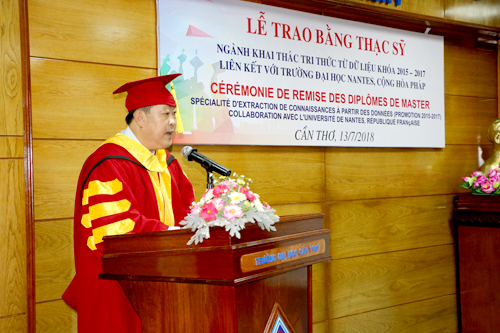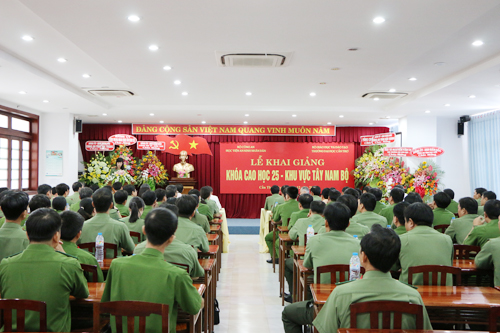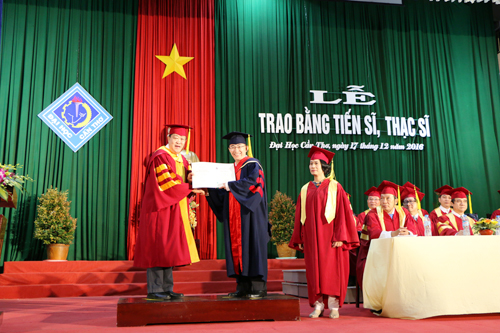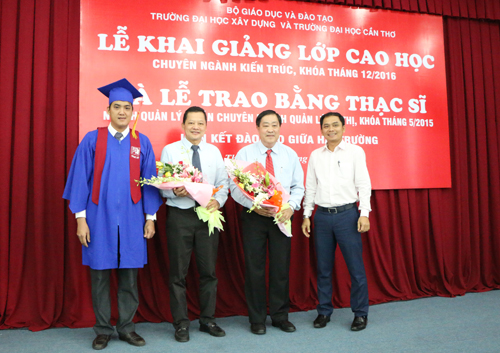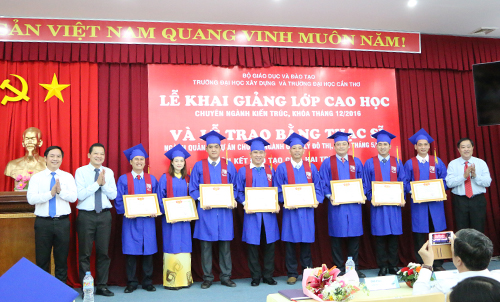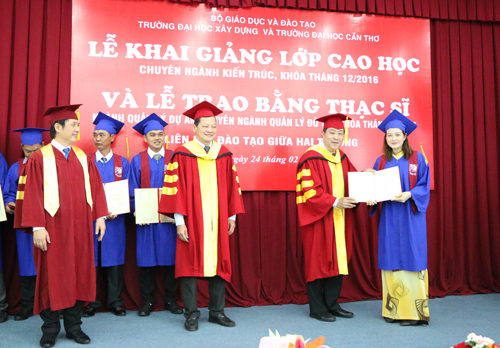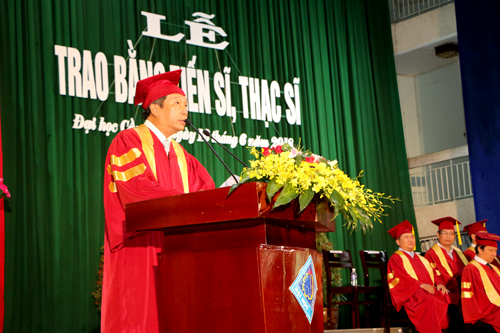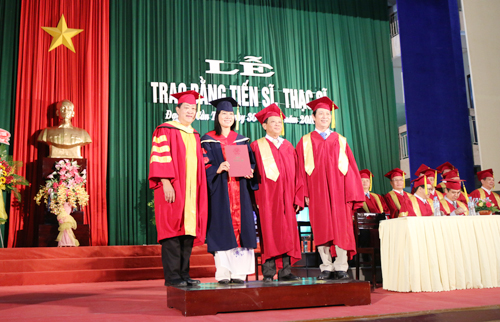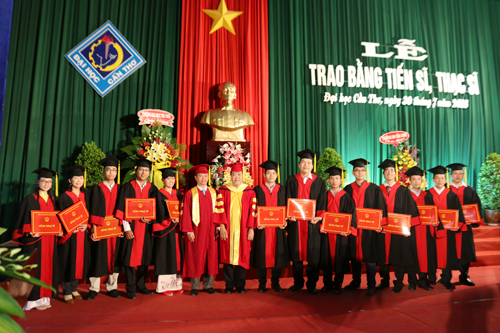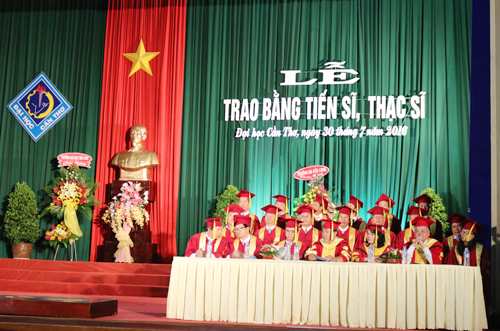
 Tên đề tài: “Khảo sát xoắn khuẩn Leptospira và Leptospirosis trên chó ở một số tỉnh Đồng Bằng Sông Cửu Long”.
Tên đề tài: “Khảo sát xoắn khuẩn Leptospira và Leptospirosis trên chó ở một số tỉnh Đồng Bằng Sông Cửu Long”.
 Tác giả: Nguyễn Thị Bé Mười, Khóa: 2013
Tác giả: Nguyễn Thị Bé Mười, Khóa: 2013
 Chuyên ngành: Bệnh lý học và chữa bệnh vật nuôi; Mã số: 62640102. Nhóm ngành: Nông, lâm nghiệp và thuỷ sản.
Chuyên ngành: Bệnh lý học và chữa bệnh vật nuôi; Mã số: 62640102. Nhóm ngành: Nông, lâm nghiệp và thuỷ sản.
 Người hướng dẫn chính: PGS.TS. Hồ Thị Việt Thu - Trường Đại học Cần Thơ.
Người hướng dẫn chính: PGS.TS. Hồ Thị Việt Thu - Trường Đại học Cần Thơ.
- Tóm tắt nội dung luận án
Đề tài “Khảo sát xoắn khuẩn Leptospira và Leptospirosis trên chó ở một số tỉnh Đồng Bằng Sông Cửu Long” được thực hiện từ năm 2013 đến 2017, sử dụng phương pháp khảo sát huyết thanh học (MAT), lấy mẫu cắt ngang được thực hiện trên 4 tỉnh Cần Thơ, Vĩnh Long, An Giang và Cà Mau với 18 nhóm huyết thanh Leptospira phổ biến.
Tổng số mẫu kiểm tra huyết thanh chó 1.433, chia thành: giống chó nội và giống chó ngoại; 3 nhóm tuổi: 4 tháng – 12 tháng tuổi, ≤1-6 năm và ≥ 6 năm tuổi; giới tính đực và cái; nuôi thả rong và nuôi nhốt. Tổng số mẫu huyết thanh chuột 647, với 3 loại chuột: chuột cống, chuột xạ và chuột nhắt. Đề tài thực hiện trên 4 nội dung là: (1) Điều tra tỷ lệ nhiễm Leptospira trên chó và chuột; (2) Phát hiện xoắn khuẩn Leptospira từ nước tiểu bằng kỹ thuật PCR và nuôi cấy, giải trình tự đoạn gene 16S rRNA của xoắn khuẩn Leptospira; (3) Khảo sát những biến đổi bệnh lý bệnh Leptospirosis trên chó thông qua xét nghiệm máu và nước tiểu và (4) nghiên cứu biện pháp điều trị bệnh Leptospirosis với 3 phác đồ điều trị bằng Shoptapen, Amoxicillin và Doxycycline.
Việc phát hiện xoắn khuẩn Leptospira được thực hiện trên 63 mẫu nghi ngờ có Leptospira từ 111 mẫu nước tiểu của chó có MAT ≥ 1: 400. Các biến đổi về bệnh lý thực hiện trên 13 chó (6 con không có và 7 có triệu chứng lâm sàng) dương tính với Leptospira bằng kỹ thuật PCR và điều trị được thực hiện tại 3 phòng mạch thú y tại TPCT.
Kết quả cho thấy tỷ lệ nhiễm xoắn khuẩn Leptospira trung bình trên chó là 23,1%; cao nhất ở TP Vĩnh Long là 26,59%, kế đến là Cần Thơ (24,46%), An Giang (20,15%) và thấp nhất là Cà Mau (18,94%). Serogroup phổ biến là L. icteroheamorrhagiae (35,05%), L. canicola (18,34%), L. hurstbridge (12,69%), L. bataviae (12,08%) và L. grypptophosa (12,08%). Tỷ lệ nhiễm xoắn khuẩn Leptospira giữa nhóm giống chó nội (23,71%) và chó ngoại (22,24%) (P=0,51) cũng như các lứa tuổi chó khác nhau, từ 4 tháng 12 tháng tuổi (22,51%), ≤1-6 năm tuổi (22,52%) và ≥ 6 năm tuổi (26,04%) (P=0,32). Tỷ lệ nhiễm Leptospira giữa chó đực (24,20%) và con cái (22,01%) (P=0,33). Tuy nhiên, phương thức nuôi có ảnh hưởng rất có ý nghĩa đến tỷ lệ nhiễm Leptospira, chó thả rong là 25,92% trong khi nuôi nhốt là 17,56% (P<0,01). Chuột có tỷ lệ nhiễm Leptospira khá cao, chuột cống 46,32%, trong khi chuột xạ và chuột nhắt lần lượt là 26,32 và 27,14% (P<0,01). Serogroup nổi trội là L. icteroheamorrhagiae (40,61%), L. canicola (20,52%), L. bataviae (13,97%), L. panama (10,92%) và L. hurstbridge (10,92%). Tỷ lệ dương tính với Leptospira giữa chuột và chó có tương quan rất chặc chẻ (R2= 0,90).
Kỹ thuật PCR đã phát hiện 13/63 mẫu nước tiểu dương tính với Leptospira (20,63%) và đã nuôi cấy thành công Leptospira từ 3/63 mẫu nước tiểu này (4,76%). Kết quả định danh xác định các mẫu phát hiện thuộc hai loài Leptospira interrogans (L. interrohans serovar icterohaemorrhagie) thuộc nhóm Leptospira gây bệnh và loài Leptospira fainei (L. fainei serovar hurstbridge) thuộc nhóm xoắn khuẩn trung gian gây bệnh cơ hội hiện diện trong nước tiểu chó ở TPCT.
Mười ba chó dương tính với Leptospira có bạch cầu tổng số, bạch cầu trung tính, lâm ba cầu, urea, creatinin, AST, ALT và bilirubin tăng cao, trong khi hồng cầu, hemoglobin, hematocrit và tiểu cầu giảm so với chỉ số bình thường, ngoài ra trong nước tiểu còn xuất hiện hồng cầu và protein cao. Bảy chó có triệu chứng lâm sàng như lừ đừ, ăn ít hoặc bỏ ăn (100%), niêm mạc nhợt màu (85,71%) và tiêu chảy (14,28%). Sáu mươi ba chó được điều trị với ba phác đồ, kết quả Doxycycline có tỷ lệ khỏi bệnh cao nhất (61,90%), kế đến là Amoxicilline (50%) và thấp nhất Shotapen (40%) (P=0,37).
Kết quả của đề tài chỉ rằng chó và chuột là hai động vật có mắc bệnh Leptospirois, tỷ lệ nhiễm Leptospira giữa chúng có quan hệ tuyến tính rất cao. Các số liệu thu được của đề tài là những dữ liệu cần thiết cho công tác phòng và chống bệnh trên chó cũng như góp phần làm hạn chế bệnh trên các động vật khác và trên người.
1.2 Những đóng góp mới của luận án
Đây là công trình nghiên cứu đầu tiên đã phát hiện 2 loài Leptospira interrogans và Leptospira fainei hiện diện trên chó chưa tiêm phòng Leptospirosis ở một số tỉnh ĐBSCL.
1.3 Ý nghĩa khoa học của luận án
Đây là công trình nghiên cứu đầu tiên về tình hình dịch tễ bệnh Leptospirosis trên chó, là cơ sở khoa học cho việc xây dựng qui trình phòng và trị bệnh trên chó, hạn chế bệnh trên người và các loài động vật khác.
- Summary
The study of “Survey of Leptospira and Leptospirosis in dogs in some provinces in the Mekong Delta" was carried out from 2013 to 2017, using for a cross-sectional sero survey of the Leptospira prevalence by microscopic agglutination test (MAT) on four provinces: Can Tho, Vinh Long, An Giang and Ca Mau with live antigens of 18 common serogroups.
A total of serum samples was 1.433, in which dogs were divided two breeds group: domestic and exotic dog’s breeds; three age groups, 4 months to 12 months, ≤ 1-6 years and ≥ 6 years-old dogs; male and female; free-raising dogs and captive dogs. A total of the tested serum samples was 647: three rat species: Rattus norvegicus, Suncus murinus and Mus musculus. The study consisted of four contents (1) Investigation the prevalence of Leptospira in dogs and rats; (2) Detection of Leptospira from urine by PCR technique and by culturing methods, sequence of the 16S rRNA of Leptospira; (3) Survey of the pathological changes of Leptospirosis on dogs through blood and urine tests and (4) examination of three antimicrobial therapies with Shoptapen, Amoxicillin and Doxycycline in the treatment of Leptospira on dogs.
The detection of Leptospira was examined on 63 clinical suspicion cases of Leptospira from 111 urine samples of dogs, all were tested by MAT ≥ 1: 400. The pathological changes were conducted on 13 dogs (6 without and 7 had clinical symptoms) that were positive for Leptospira by PCR technique and the treatments were conducted at 3 veterinary clinics in Cantho city.
Results showed that the average prevalence of Leptospira in dogs was 23.10%, the highest rate was reported in Vinh Long province (26.95%), followed by Can Tho city (24.46%), An Giang province (20.15%) and the lowest was in Ca Mau city (18.94%). The common serogroups were L. icterohaemorrhagiae (35.05%), L. canicola (18.43%), L. hurstbridge (12.69%), L. bataviae (12.08%) and L. gryppotyphosa (12.08%). The seroprevalence of Leptospira between domestic dog’s breeds group was (23.71%) and exotic dog’s breeds group (22.24%) (P=0.51) as well as among age groups of dogs: from 4 months to 12 months (21.51%), ≤ 1-6 years old (22.52%) and ≥ 6 year-old dogs (26.04%) (P=0.32). The prevalence of Leptospira between males dogs was 24.20% and 22.01% in female (P=0.33). Howerver, keeping methods had significantly influenced on the prevalence of Leptospira with 25.92% found in free-raising dogs, while in captive dogs was 17.56% (P<0.01). There was high positive prevalence of Leptospira observed in rats (35.40%), in which the highest percentage found in Rattus norvegicus (46.32%), while Suncus murinus and Mus musculus were 26.32% and 27.14%, respectively (P<0.01). The common serogroups were L. icterohaemorrhagiae (40.61%), L. canicola (20.52%), L. bataviae (13.97%), L. panama (10.92%), and L. hurstbridge (10.92%). The positive prevalence Leptospira between rats and dogs was highly correlated (R2=0.90).
The PCR technique detected 13/63 Leptospira positive urine samples (20.63%) and Leptospira was successfully cultured from 3/63 urine samples (4.76%). Identification results based on homology and comparison of 16S rNRA gene nucleotic sequences had identified the Leptospira detected samples belonged to two species of Leptospira interrogans (L. interrogans serovar icterohaemorrhagiae), which is pathogenic Leptospira species and L. fainei (Leptospira fainei serovar hurstbridge) is the associated pathogenic spirochetes, occurred in dog urine in Can Tho city.
Thirteen dogs positive for Leptospira had the white blood cell, neutrophil, lymphocyte counts, urea, creatinine, AST, ALT and bilirubin levels higher than normal ranges, whereas the red blood cell, hemoglobin, hematocrit and platelet counts were lower than those of normal; and there were the presence of red blood cell and protein in urine. Seven dogs with clinical symptoms of Leptospirosis included lethargy, reluctant to eat and anorexia (100%), colorless mucus (85.71%) and diarrhea (14.28%). Sixty- three infected dogs treated with Doxycycline had the highest recovery rate (61.90%), followed by Amoxicillin (50%) and the lowest was Shoptapen (40%) (P=0.37).
The study indicated that canine and rodent were two infected animal species with Leptospirosis. There was a high linearly correlated in the prevalence of Leptospira between dogs and rats. This research is necessary for the prevention, against as well as contributes to limit the bacteria potential exposure of rodent to domestic animals and human.
1.2 Research creativeness
This is the first research discovered two species Leptospira interrogans and Leptospira fainei presence in unvaccinated dogs leptospirosis in some provinces in the Mekong Delta.
1.3 Scientific significance of the study
This is the first research about the epidemiological of leptospirosis in dogs, as well as a scientific basis for the construction process and treatment of the dog, limiting disease in humans and other animals.
- Xem chi tiết nội dung luận án
- Xem thông tin đăng tải tại Website Bộ giáo dục và Đào tạo. (Nhập tên NCS vào ô tìm kiếm)





